Ranomafana National Park was established in 1991 after primatologist Patricia Wright visited to study the Greater Bamboo Lemur (Prolemur simus) and found out that the area was also home to a new-to-science species that was named the Golden Bamboo Lemur (Hapalemur aureus). More on that later.
Ranomafana is mostly hilly rainforest, from mid-elevation up to cloud forest. The bustling Ranomena river runs through it, along with many streams and creeks. It is a wet place.
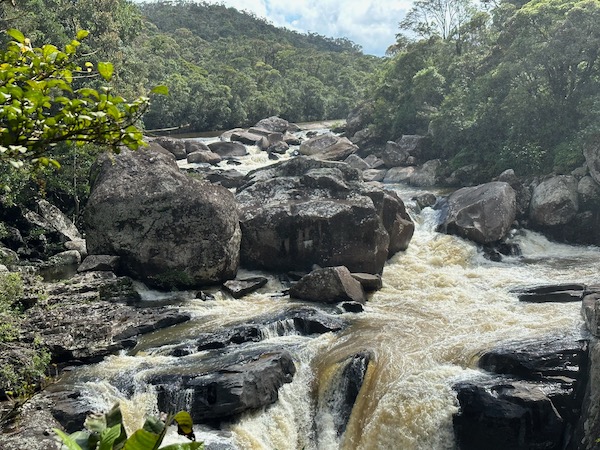
The Ranomena river
We stayed in the Ranomafana area for four nights, at a lovely establishment called Setam Lodge. During the day we would visit the park itself or look for particular species in areas near the park. Visitors are not allowed in any of Madagascar's national parks at night (grrr), so some nights we walked along the forest edge on the main road and other nights we checked out interesting habitats that were not in the park.

We saw no actual Madagascan Moon Moths here (or anywhere else)
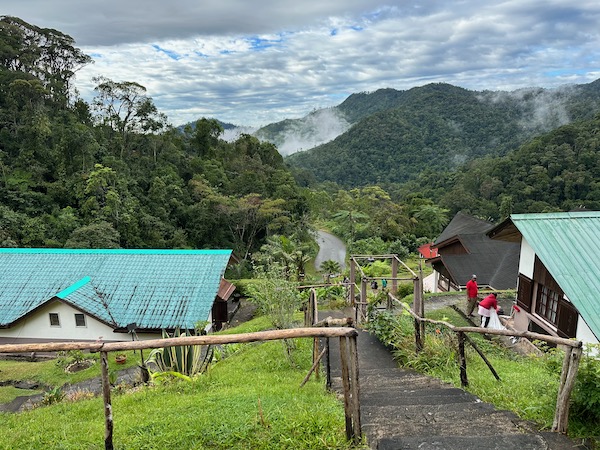
The view from my room down towards the road

Rainer rests, José wrangles, and Ryan photographs
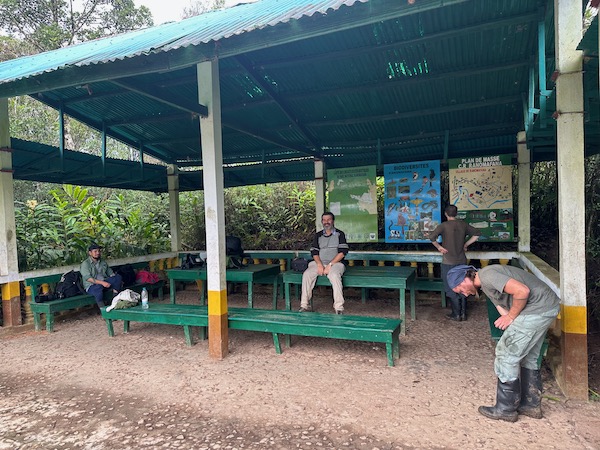
Frank, Rainer, and José rest while Ryan reads
At all of Madagascar's national parks, visitors must be accompanied by a licensed local guide. We were extremely fortunate that Rainer had arranged for our local guide to be the legendary Emile Rajeriarison. He is the most senior guide at Ranomafana and has held that title since the park opened. In fact, he was a local guide even before that; he guided Patricia Wright when she was looking for the Greater Bamboo Lemurs back in 1986 and he also found the Golden Bamboo Lemurs that she is usually credited with discovering. He was also the guide for my small group when I visited Ranomafana in 2007, and on that trip he showed me pages from the then-upcoming 3rd edition of Glaw & Vence's Madagascar herp guide (aka The Authority); he had these pages because he had helped the authors so much when they did research in the area.
Emile knew exactly where and how to look for every interesting herp species. He found or helped us find many species that we would not have seen otherwise.

Emile Rajeriarison in his small vanilla plantation, with a friend
As usual, I'll start off the parade of Ranomafana animals with some invertebrates.
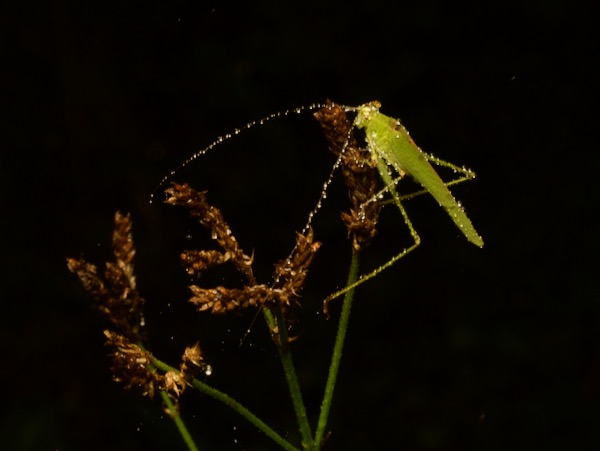
Sickle-bearing Leaf Katydid,
Phaneroptera sparsa
I did mention that Ranomafana is a wet place. We, and all the local flora and fauna, were drenched with rain on more than one night walk.

Silver Widow,
Palpopleura vestita
One of the more dramatic-looking dragonflies in the area.

Madagascar Demoiselle,
Phaon rasoherinae
These were large and beautiful damselflies, with a metallic emerald sheen.

Whitebar Acraea, Telchinia encedon
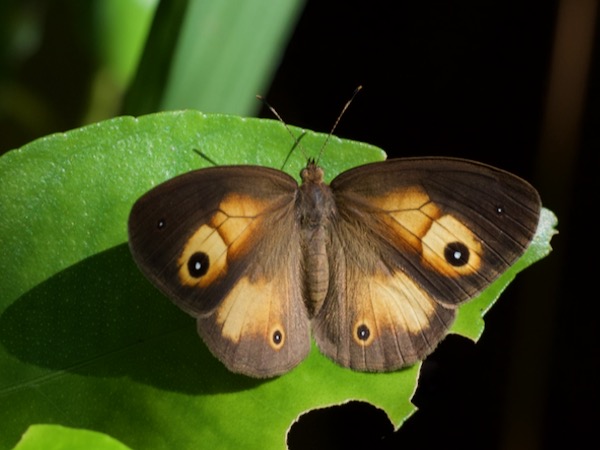
Heteropsis sp.
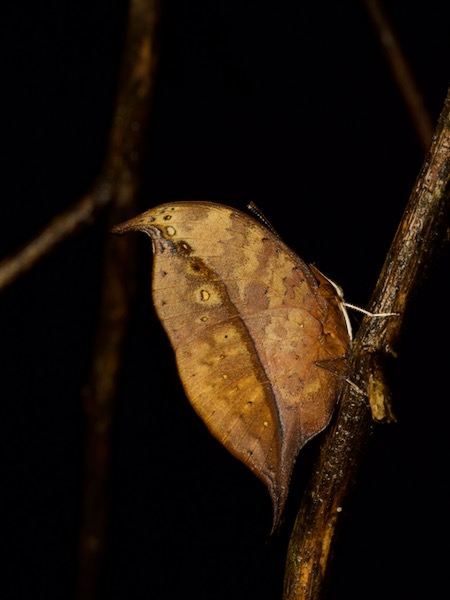
Malagasy Leaf Commodore,
Precis eurodoce
Could be my all-time personal favorite butterfly-that-looks-like-a-dead-leaf.
When I had the chance, I'd leave my bungalow's front-porch light on while I was out of the room. When I returned, I'd photograph the collection of insects that had been attracted to the light. Most of these were moths.

Eurrhyparodes tricoloralis, plus unidentified li'l hopper

Glyphodes toulgoetalis
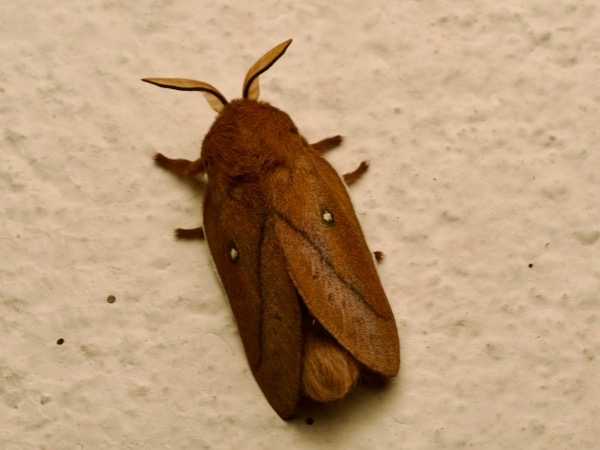
Phoenicladocera sp

Zebra Pyrale, Zebronia phenice
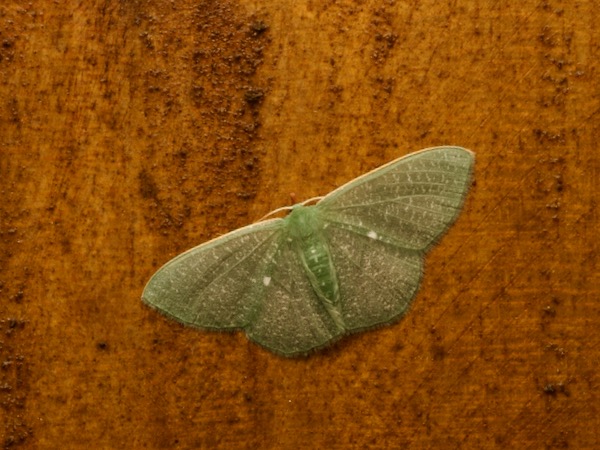
I haven't gotten anywhere with identifying this beauty
Of course, many a fine moth could also be found at night in the forest.
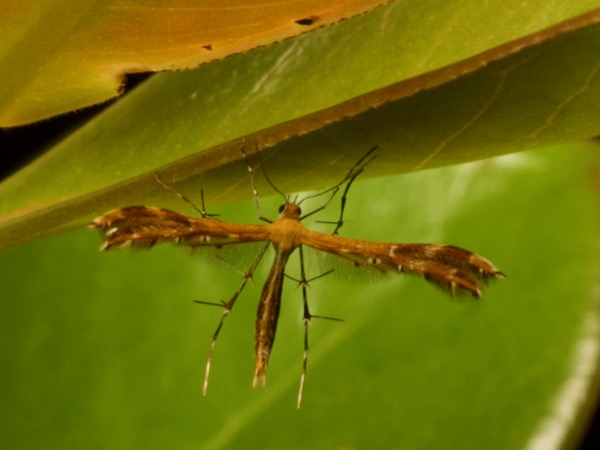
Unknown plume moth, family Pterophoridae
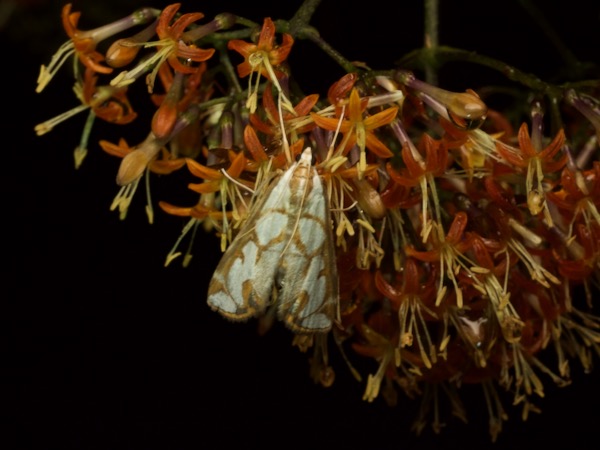
Orphnophanes ankarampotsyalis (now that is a scientific name!)
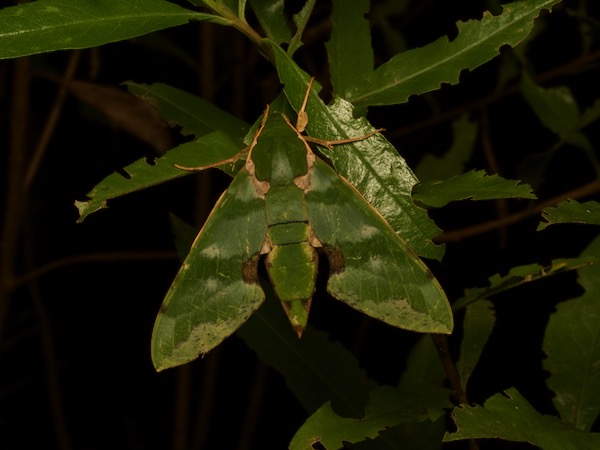
Verdant Hawkmoth, Euchloron megaera
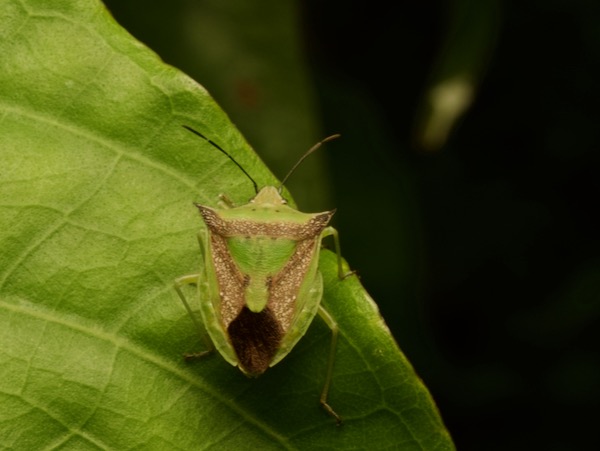
Veterna nigromarginata

Piezodera rubra (no relation to
Pia Zadora, as far as I know)

Prosopocoilus serricornis
Some beetles joined the moths gathered around my bungalow's front porch when I left the light on.
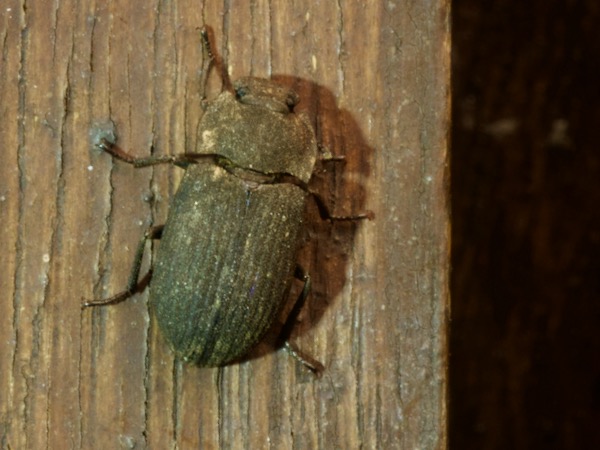
A dusty surface beetle,
Gonocephalum sp.
I wish I knew the origin story for the English name of this group of beetles. Are they often found on dusty surfaces? Are they dusty, and often found on the surfaces of things?

Arrhythmus rugosipennis
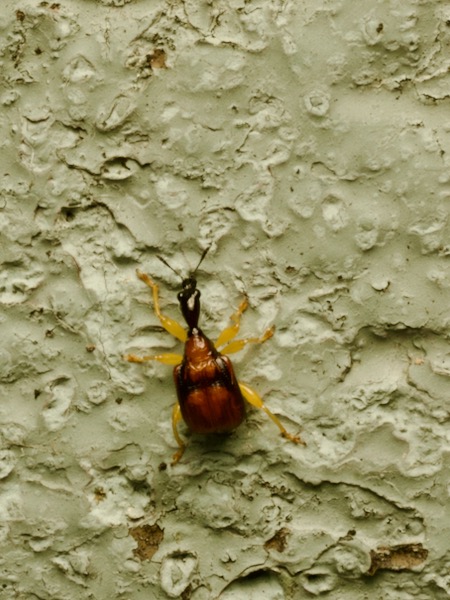
Trachelophorus (Cycnotrachelus) limbatus
Trachelophorus giraffa is Madagascar's most famous insect, the Giraffe Weevil. The other closely related species spend their little lives clothed in obscurity. Sometimes they are found near porch lights.

Trachelophorus madegassus
And sometimes they are found on leaves in the shrubs around town.

Trachelophorus humeralis
And sometimes they are found on your arm.

Polyspilota sp
This is one of your standard-shaped mantises, apparently in a festive Christmassy mood.
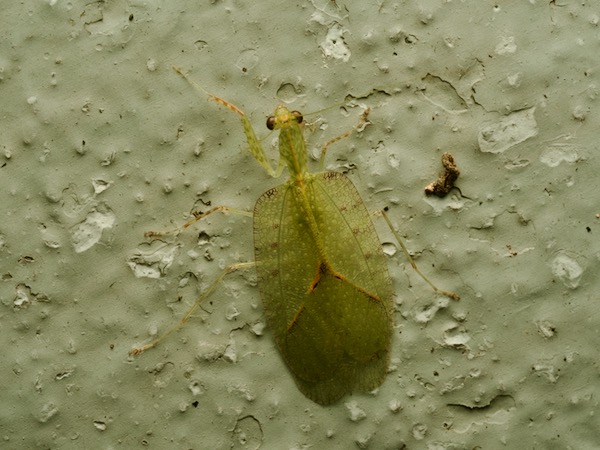
Enicophlebia pallida
This is one of your non-standard-shaped mantises, here photographed in situ on the unattractive peeling painted stucco of my bungalow. José borrowed this mantis for a while to take some actually attractive photographs.
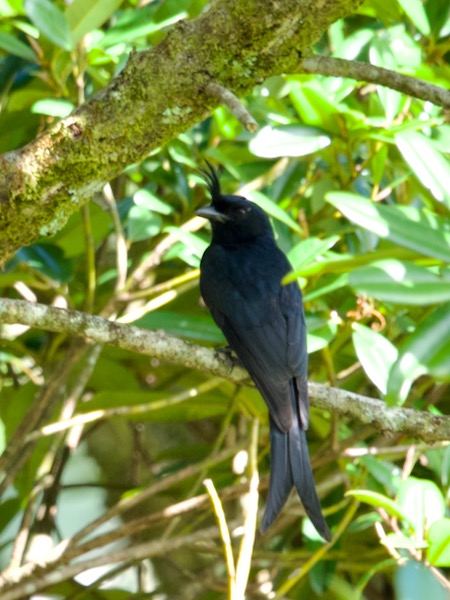
Crested Drongo,
Dicrurus forficatus
I was not successful at becoming a world-class bird photographer while at Ranomafana. But here is one of the most common Malagasy birds, bearing an enjoyably silly name
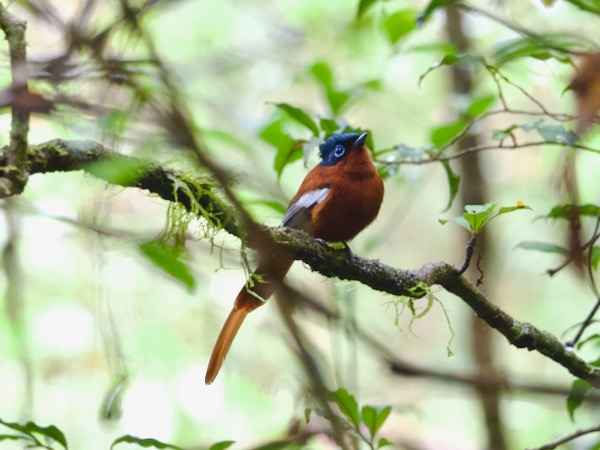
Malagasy Paradise-Flycatcher,
Terpsiphone mutata
This is my only other Ranomafana bird photo worth sharing.

Ranomafana Bamboo Lemur,
Hapalemur griseus ranomafanensis
Most people who visit Ranomafana are primarily looking for lemurs, and they generally see lots of lemurs of various species. We had a different agenda, and we only saw a few lemurs. Of course the lemurs were cute, but there were lizards and snakes and frogs to find, so we couldn't spend too much time on our furry relatives.

Greater Bamboo Lemur,
Prolemur simus
Sadly, this adult female was the only remaining member of her family group. Ten or so members of another group from a nearby area had been brought in to see if she would join them. So far it hadn't happened, but the other group had only been released a few days earlier. Fingers crossed.

Tanala Tufted Rat,
Eliurus tanala
One of my very few non-lemur mammal sightings from this trip. There are non-native Norwegian Rats in Madagascar, but happily this one's slightly hairy tail gives it away as a native species.
We didn't see as many individual frogs or species of frogs at Ranomafana as we did around Andasibe, but we did see some particularly excellent ones.

Mascarene Ridged Frog,
Ptychadena mascareniensis
This is not one of the particularly excellent ones, as it is very widespread and very common in Madagascar. Nice green stripe though.

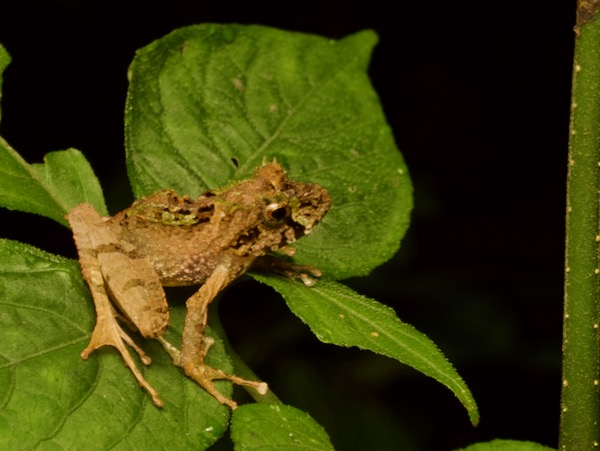
Gephyromantis ceratophrys
Glaw & Vences would have called these
Gephyromantis asper, but
a 2017 study reassigned the "
G. asper" in Ranomafana to
G. ceratophrys.
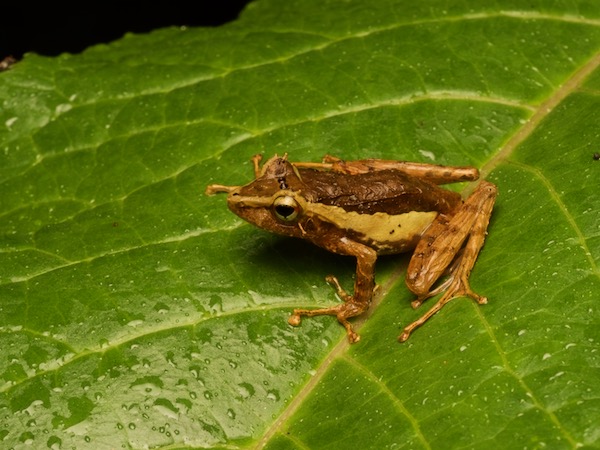
Tschenk's Madagascar Frog,
Gephyromantis tschenki
I think this one is a different but related species. The yellow stripes are not actually a big clue, as those are present on some individuals of various Gephyromantis species. But the skin texture and overall proportions seem significantly different to me, and G. tschenki seems like the best match.

Anodonthyla moramora
Anodonthyla moramora is a highly localized species that's similar to the Anodonthyla boulengeri that we had seen near Andasibe and at Akanin'ny Nofy. This species is a little smaller and a little greener and has a somewhat different call.
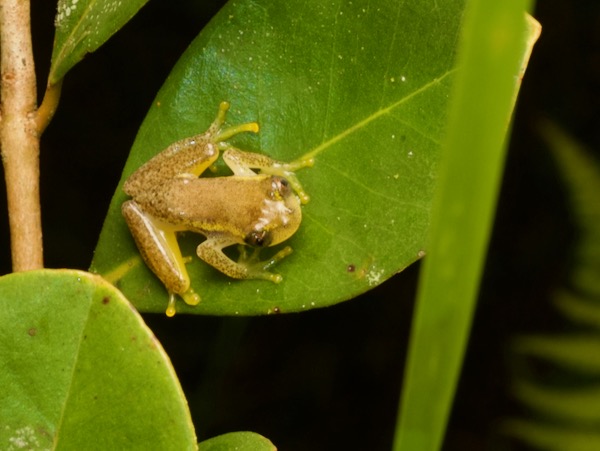
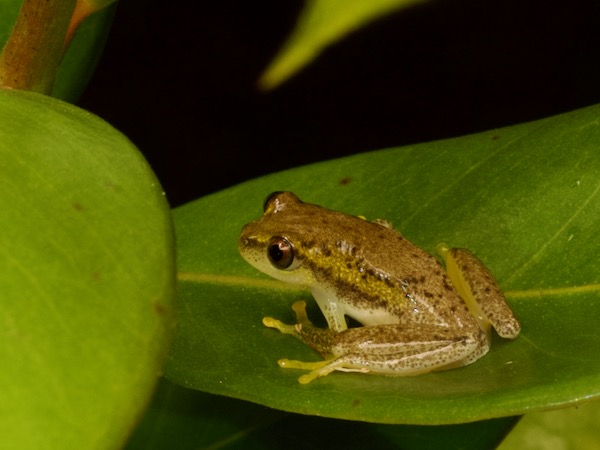
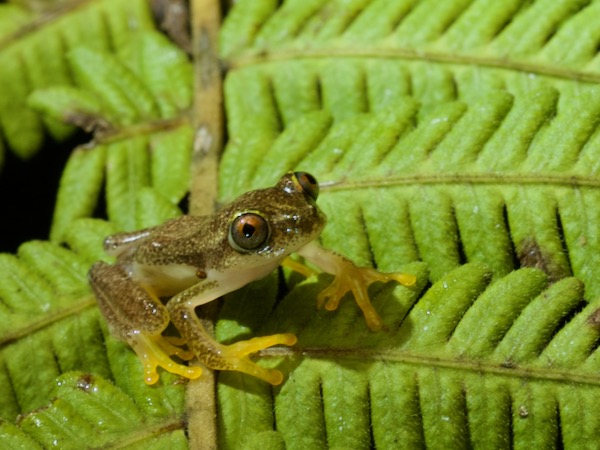
Betsileo Reed Frog,
Heterixalus betsileo
One night we walked along one particular section of road in search of one particular gecko species. We found numerous Heterixalus frogs, which as a group are easy to recognize due to their "vertical rhomboid"-shaped pupils. However, individual species are not always easy to distinguish. These frogs were all small enough to be juveniles, which are even harder to tell apart. But still, I think these are Heterixalus betsileo based on some details of the appearance.
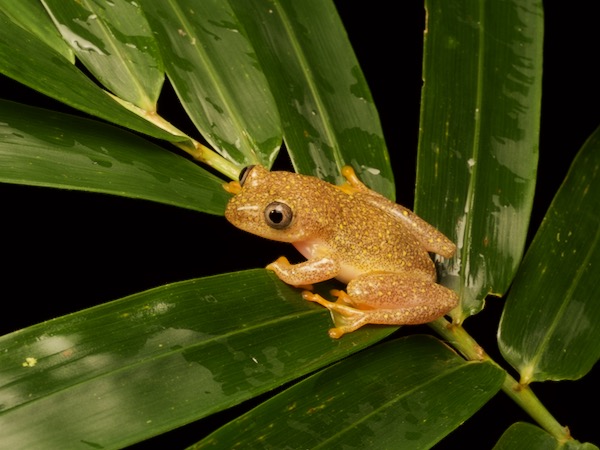
Starry Night Frog,
Heterixalus alboguttatus, adult male
This is the other Heterixalus species in the area. Males have faint spots covering their dorsal surface, and are not particularly distinctive.
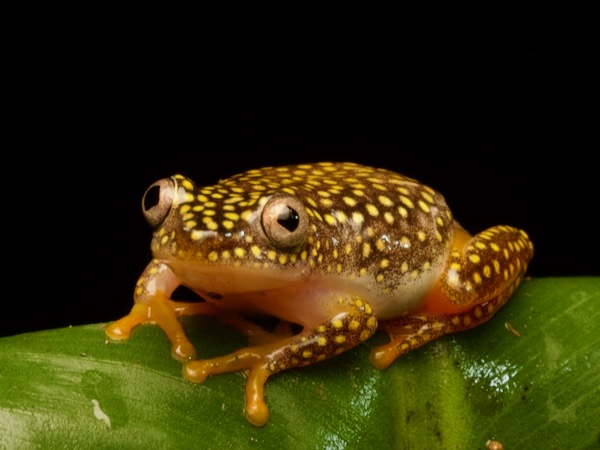
Starry Night Frog,
Heterixalus alboguttatus, adult female
Females, on the other hand, are among the most striking frogs in the country.

Dumeril's Bright-eyed Frog,
Boophis tephraeomystax
This frog looks like it has something to hide.

Boophis tasymena
Madagascar has a few Boophis species that are green with red markings. I think the fairly evenly spaced small red dots over the entire body and legs mean that this one is Boophis tasymena.
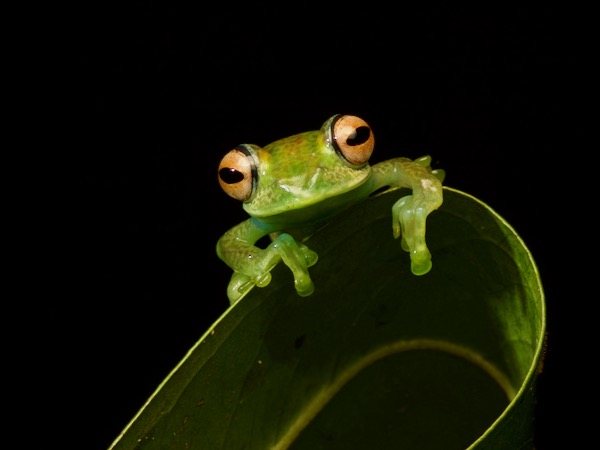
Elena's Bright-eyed Frog,
Boophis elenae
Some of the many green Boophis species can be distinguished by their eye colors.

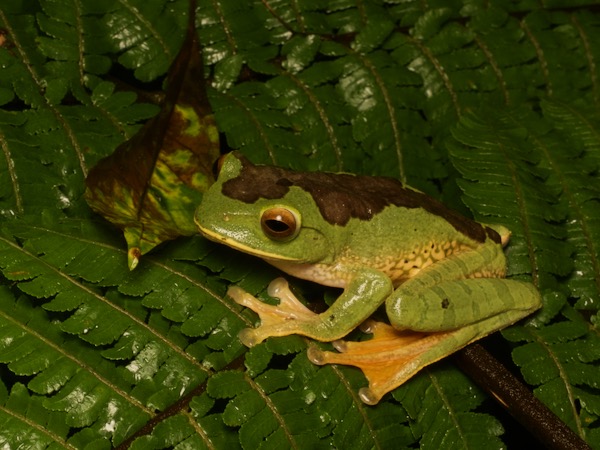
White-lipped Bright-eyed Frog,
Boophis albilabris
With its hugeness and its light-colored chin and lip, this species is easy to recognize. The weird back and side markings are highly variable between individuals.

Dumeril's Madagascar Frog,
Mantidactylus lugubris
This is one of my favorite frogs from this trip. Emile took us on a walk around part of the town of Ranomafana looking for various species that he knew we might find there (including the Starry Night Frog). We paused on a footbridge across a shallow stream/river to look down for this species on some rocks just below the bridge. We saw a few of them, but they hopped away before we could get decent photos. So Frank and José climbed over the handrails and leaped four or five feet down onto a sandbar to catch a couple of these frogs and bring them back to the rocks, where we fulfilled our photographic yearnings. As you might imagine from this story, these frogs are commonly found perched on rocks along streams, where they blend in extremely well.


Baron's Mantella,
Mantella baroni
Clearly this is the most excellent frog that we saw in Madagascar. This group of frogs occupies the same ecological niche as the "poison dart" frogs of Central and South America in the family Dendrobatidae; they hop around in the leaf litter by day eating ants and other small invertebrates from which they sequester toxins, making themselves poisonous to predators, and they brag about their dangerousness by displaying bright colors. I am told this species is pretty easy to find during the wet season, but we visited after the wet season and they were not at all easy to find. Fortunately Emile knew exactly where and how to look for them. He and Frank each found one individual, which rightfully earned them our eternal gratitude.

Common Madagascar Cat Snake,
Madagascarophis colubrinus
While looking for interesting frogs, we came across a couple more of this widespread species that we had also seen at Akanin'ny Nofy.

Lateral Water Snake,
Thamnosophis lateralis
I was taking photos of the Trachelophorus weevil that landed on my arm (pictured earlier) when I glanced down and saw this snake lurking in the ground cover below. I slowly turned my camera and got this one photo, then tried to grab the snake before it could disappear back into thicker vegetation. Frank or José would have caught it for sure. I did not. This made me feel guilty, because (1) I had already seen this species on an earlier trip, and (2) we did not see any others on this trip. Sorry everyone!
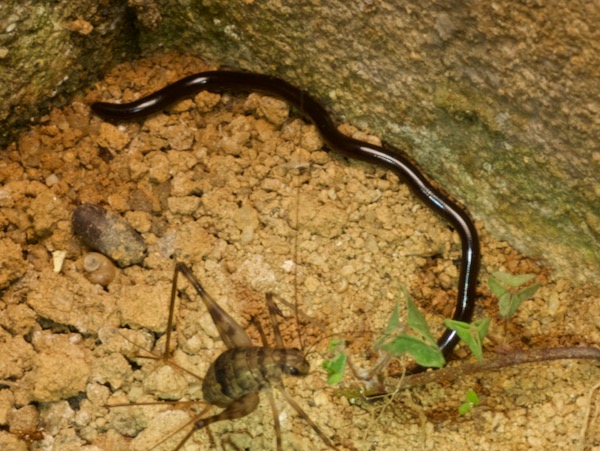
Brahminy Blind Snake,
Indotyphlops braminus
This one made me feel even guiltier. Before we went out for our night hike, I was poking around behind my bungalow taking photos of invertebrates like this goofy cricket. A small dark millipede caught my attention for a moment and I took this one photo, then moved on. Later, just before I went to bed, I downloaded my photos for the day onto my iPad and quickly reviewed them. Umm, that millipede had no legs. D'oh! This was the only blind snake any of us saw on this trip. Sorry everyone!

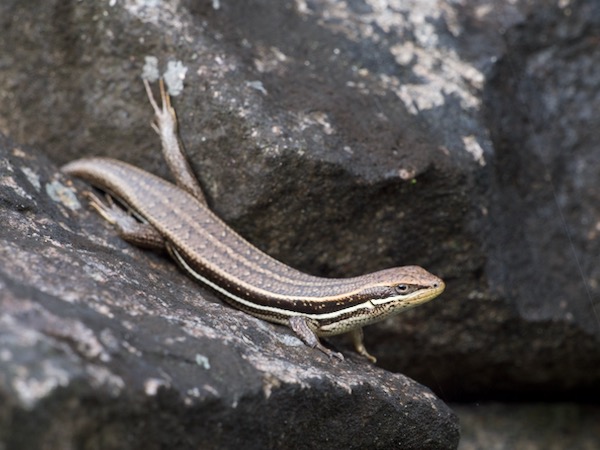
Gravenhorst's Mabuya,
Trachylepis gravenhorstii
This was the least interesting lizard I saw around Ranomafana, assuming it really is the widespread and common skink Trachylepis gravenhorstii rather than one of the similar looking but less common Trachylepis species. I saw these on rock piles in open areas, rather than in the forest.


Ornate Girdled Lizard,
Zonosaurus ornatus
When I was at Ranomafana in 2007 I came across a beautiful Zonosaurus ornatus, so I was hoping to see another in this area. I needn't have worried; we saw four or five on the stonework of Setam Lodge, and a few more elsewhere.
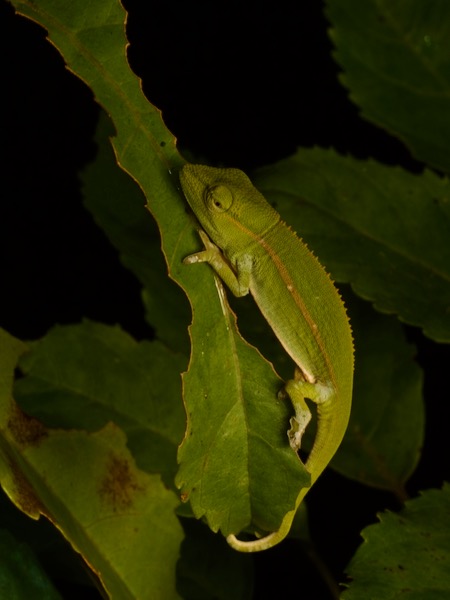
Perinet Chameleon,
Calumma gastrotaenia
Back in Anjozorobe and around Andasibe, Calumma gastrotaenia was the common little green chameleon. They live around Ranomafana also, but are not so common. I saw many small green chameleons in the area, but this was the only individual that I identified as Calumma gastrotaenia.
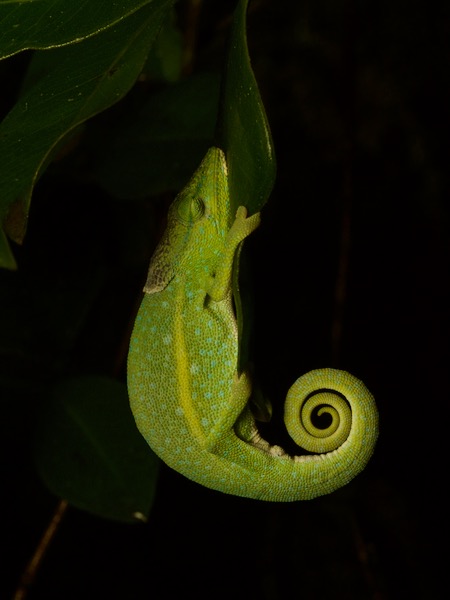

Glaw's Chameleon,
Calumma glawi
The common small green chameleon in these parts was
Calumma glawi, named in honor of Frank Glaw, co-author of the definitive (though ever more outdated)
field guide to herps of Madagascar. On our first night in the area we scoured the roadside vegetation and found 11 of these, along with 60+ other chameleons(!).
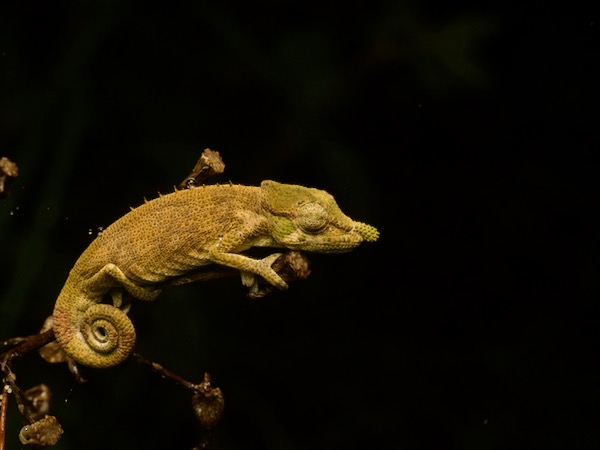
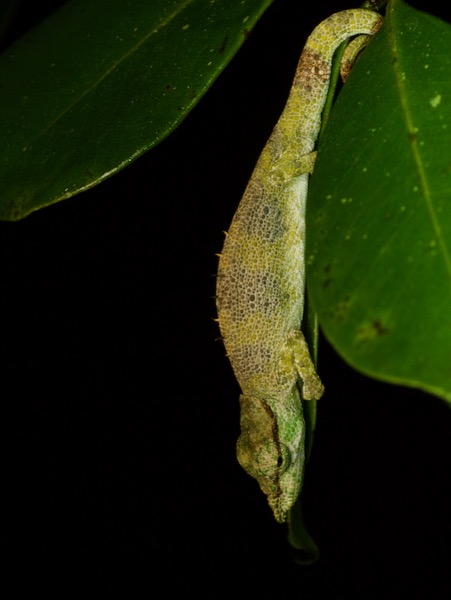
Ranomafana Nosed Chameleon,
Calumma tjiasmantoi
More than half of those 60+ other chameleons were members of the
Calumma nasutum species group, i.e., small brown chameleons with funny noses. I dutifully photographed every individual I found or that was shown to me, and posted them all
on iNaturalist where more knowledgeable folks could often distinguish one species of small brown chameleon with a funny nose from the next.
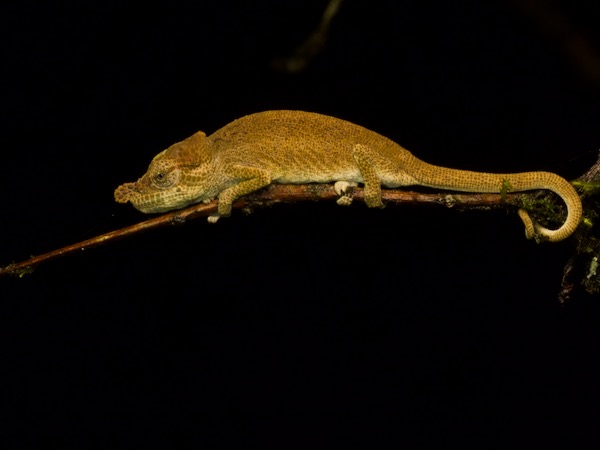

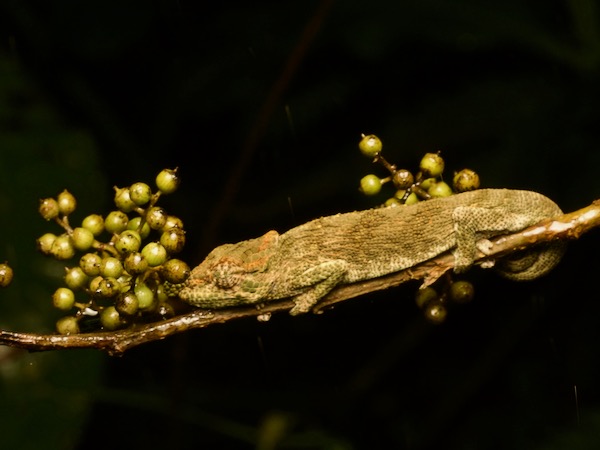
Deceptive Chameleon,
Calumma fallax
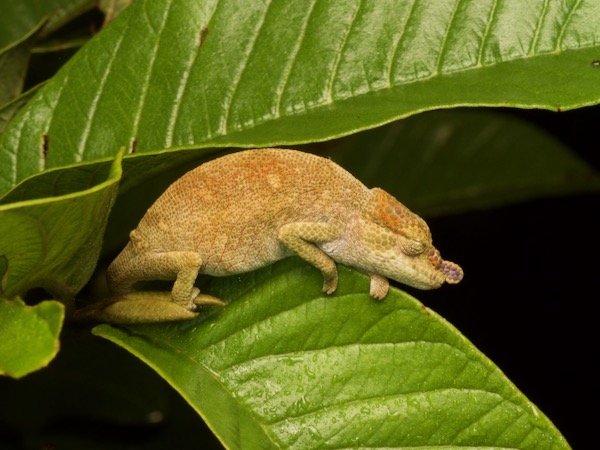
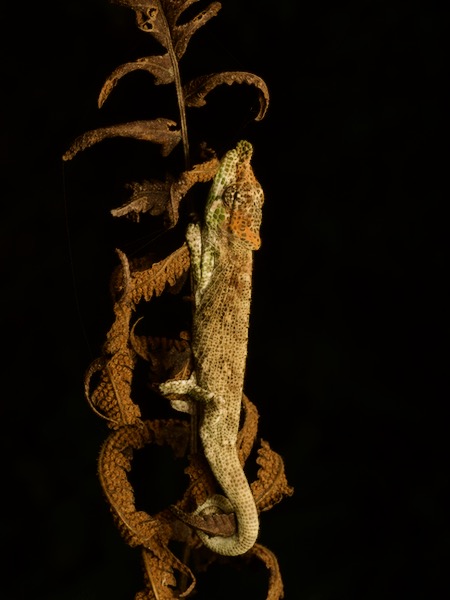
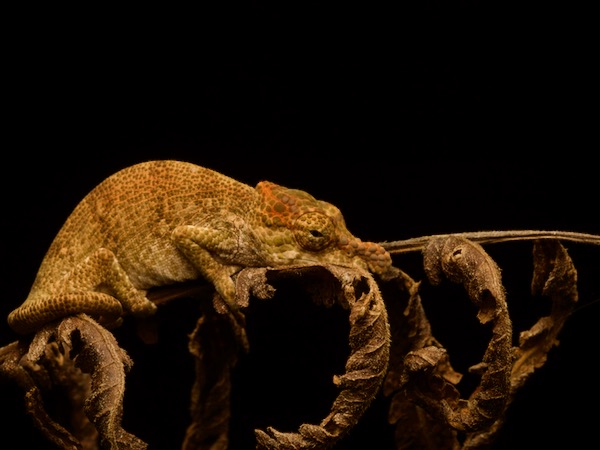
A few of many as-yet-unidentified members of Calumma nasutum species group

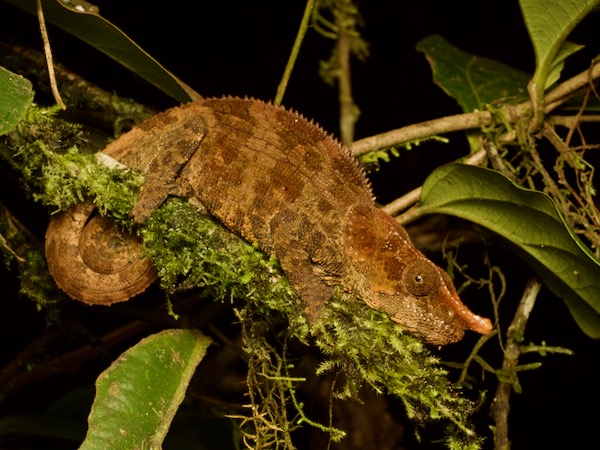
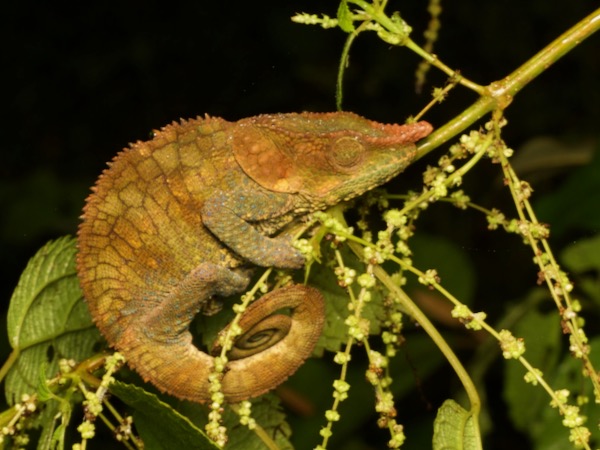
Cryptic Chameleon,
Calumma crypticum
We also saw plenty of medium-sized brown chameleons with funny noses.
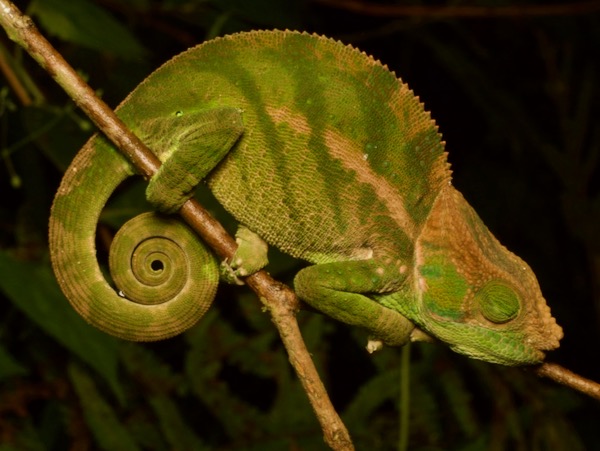


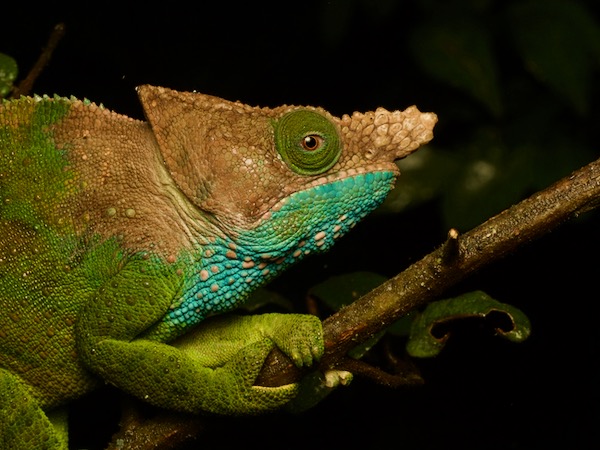
O'Shaughnessy's Chameleon,
Calumma oshaughnessyi, adults
This same roadside habitat also served as home for plenty of these big green chameleons (also with funny noses).
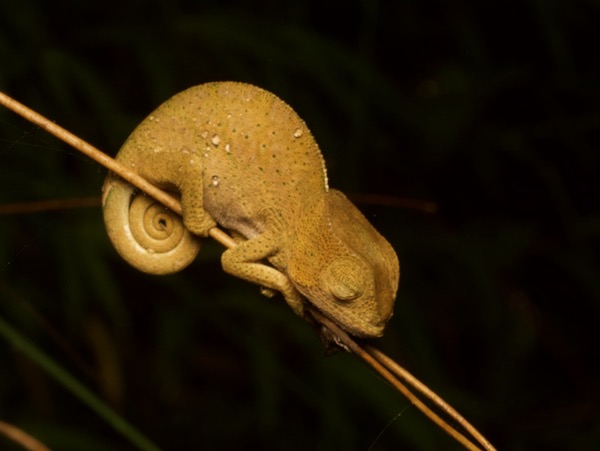
O'Shaughnessy's Chameleon,
Calumma oshaughnessyi, juvenile
Little baby O'Shaughnessy's Chameleons are not necessarily green or even greenish, but they have the same distinctive mix of bigger scales (the dark spots here) and smaller scales.

Canopy Chameleon,
Furcifer willsii, juvenile
Speaking of little baby chameleons, this cute li'l Canopy Chameleon is the only individual of that species that we saw around Ranomafana.

Parson's Chameleon,
Calumma parsonii parsonii, juvenile
And still speaking of little baby chameleons, the white spot on the side helps identify this as Calumma parsonii.
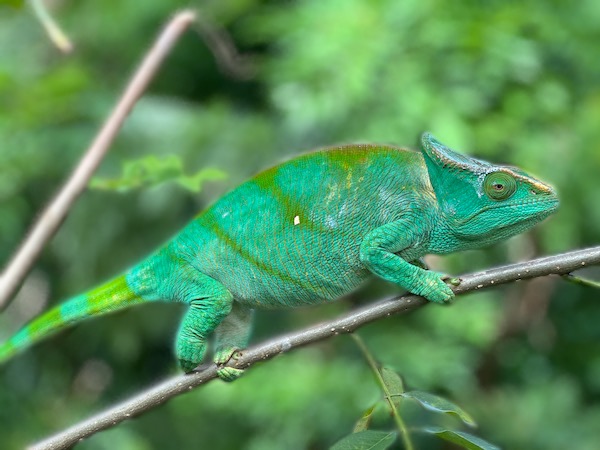
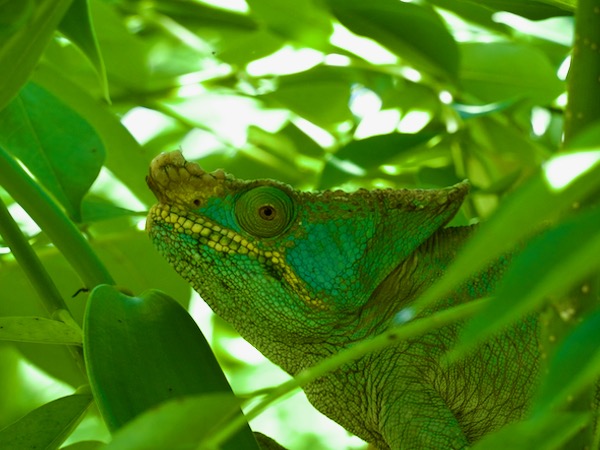
Parson's Chameleon,
Calumma parsonii parsonii, juvenile
At his personal small vanilla plantation, our guide Emile and his wife pointed out their resident adult female and male Parson's Chameleons.
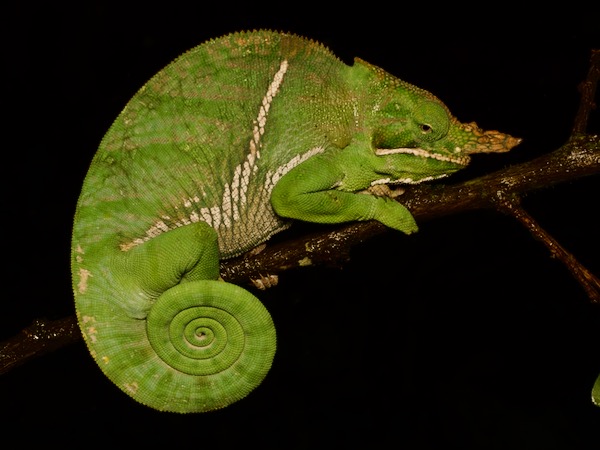
Two-banded Chameleon,
Furcifer balteatus, adult male
One evening Emile led us on a walk through part of the village of Ranomafana, where we found a variety of species that didn't require much forest to get by. The highlight was this huge Two-banded Chameleon, which somebody (Emile, I think?) spotted maybe 15 feet high in an isolated tree. So far so good! But how were we to get this distant chameleon into the range of our eager cameras? This puzzle was solved by Emile's secret weapon, his adult son, who shimmied as high as he could up into the tree and then enticed the chameleon to climb onto the end of a very long stick.
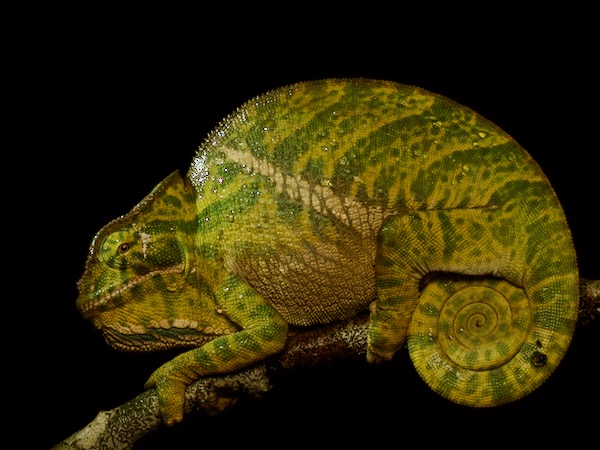
Two-banded Chameleon,
Furcifer balteatus, adult female
Later that night when we returned to Setam Lodge, one of the employees showed us this adult female that he had spotted earlier in the vegetation near my room. These were the only two Furcifer balteatus that we saw on this trip.
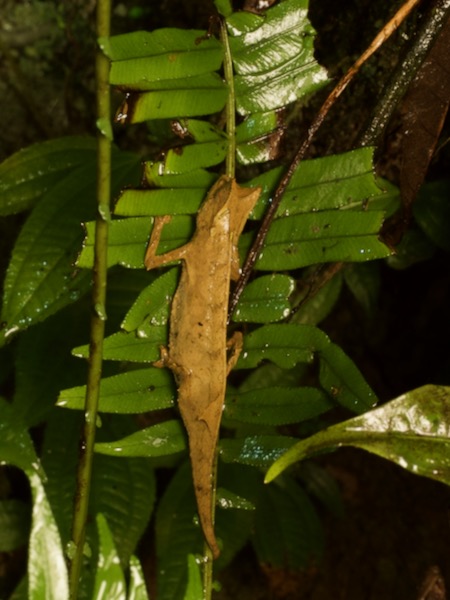
Perinet Leaf Chameleon,
Brookesia therezieni
Surprisingly, at least to me, we saw only this one Brookesia around Ranomafana, in contrast to the 20+ we had seen around Andasibe.

Elongate Leaf Chameleon,
Palleon nasus, adult male
But Brookesia schmookesia, I say. This is the little brown ground-dwelling chameleon that we most wanted to see! To be fair to Brookesia, this species was formerly considered to be included in that genus, but has since been determined to be different enough to get a genus of its own (well, shared with one other species). Part of its distinctiveness is its pointy nose and side-to-side flattened appearance, which, along with a thin but noticeable crest along the back and tail, caused José to deem it the Empanada Chameleon. Emile knew where and how to look for this species (of course), and we spent considerable time looking for an Empanada before Emile's son found this one.
Amazingly, Ryan was not impressed. He thought it was a perfectly fine chameleon, but it didn't look enough like an empanada compared to the picture he had created in his mind. Heresy!

Elongate Leaf Chameleon,
Palleon nasus, adult female
José absolutely refused to let anyone be disappointed in the herps we found, so naturally he took every moment of our so-called down time over the next few days to keep looking until he found an even more empanada-like specimen. I believe Ryan was satisfied with this one. ¡Empanada!

Striped Day Gecko,
Phelsuma lineata
Like everywhere else we had visited in the eastern rainforests, Ranomafana sported a population of these common day geckos.
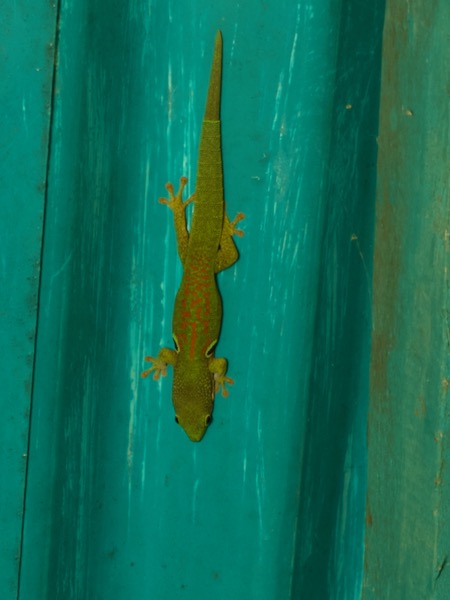
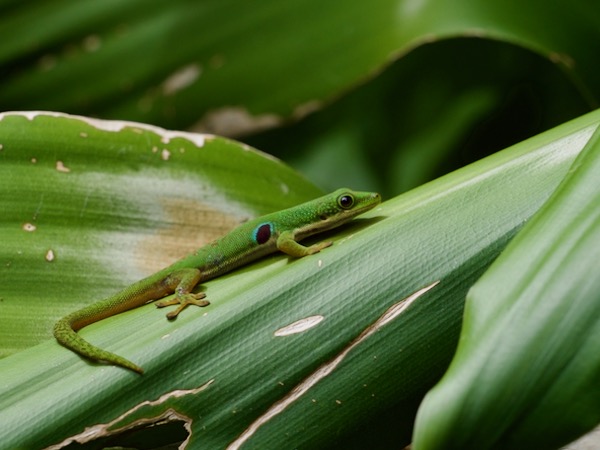
Peacock Day Gecko,
Phelsuma quadriocellata
Somewhat larger than and, with its big blue-ringed underarm stains, more distinctive than P. lineata, this was the only other day gecko we found in the area.
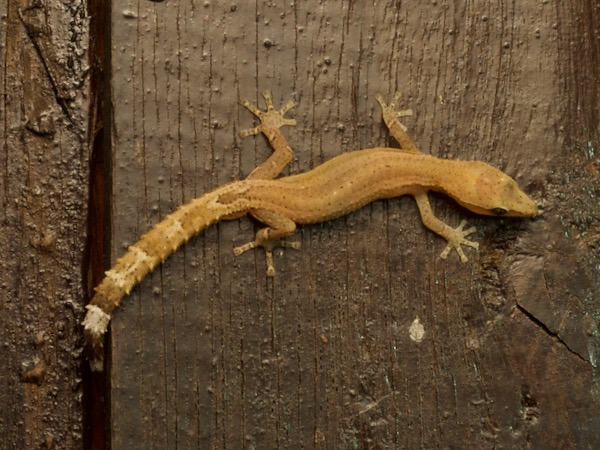
Boettger's Clawless Gecko,
Ebenavia boettgeri
This fine fellow greeted me on the side wall of my bungalow upon my return from one of our nightly hikes.
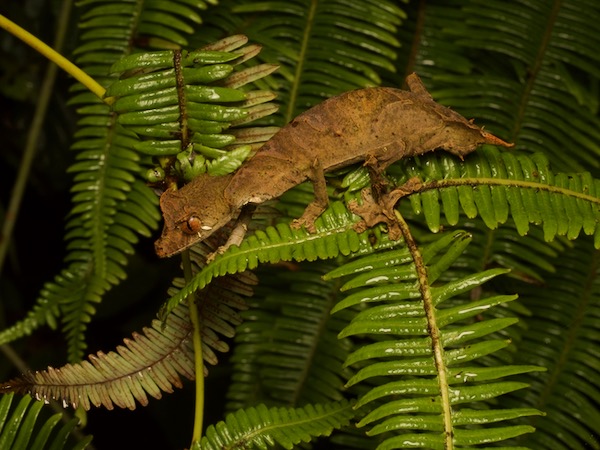
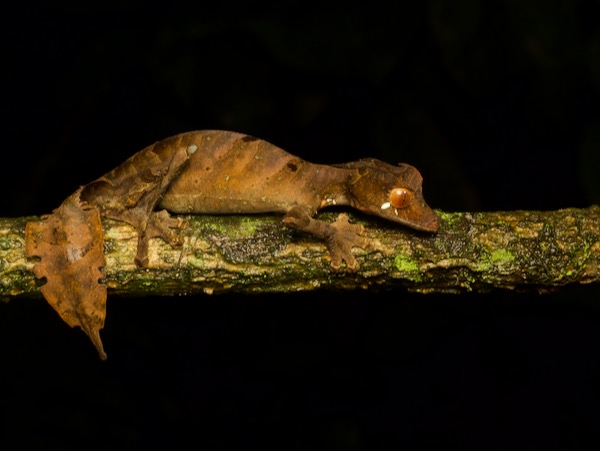
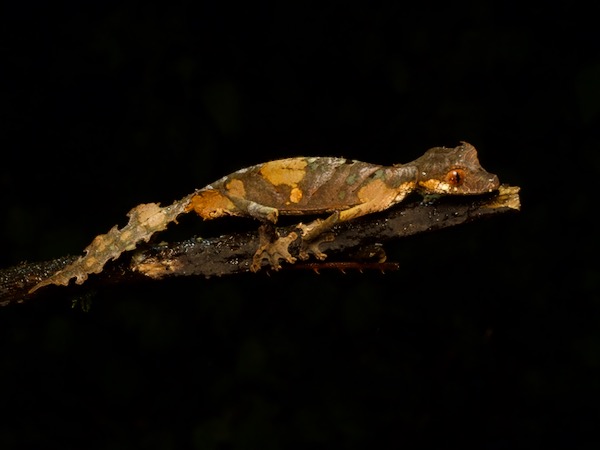
Satanic Leaf-tailed Gecko,
Uroplatus phantasticus
Another rainforest, another round of these amazing geckos. On my first trip to Madagascar, I saw none of these. On my second trip, I saw three. On this trip, I saw ten. This is the right kind of trend!
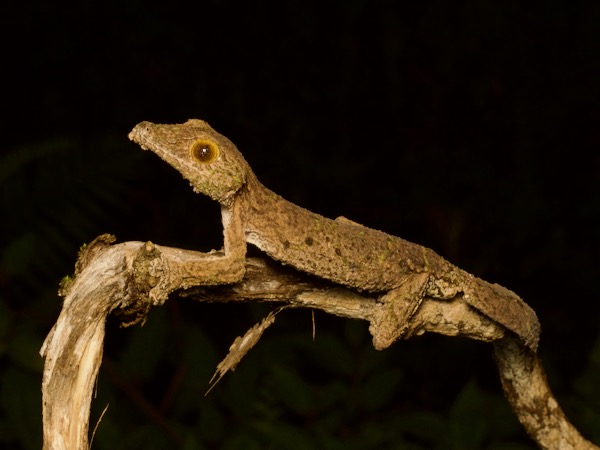

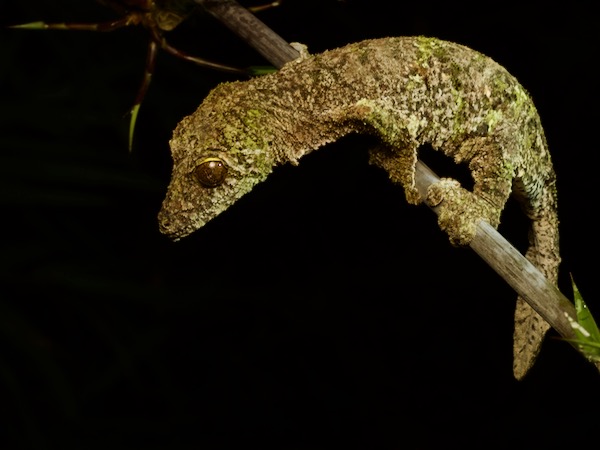
Southeastern Lowland Leaf-tailed Gecko,
Uroplatus sameiti
We had looked for this species on the two previous nights without success, but the third time was a charm. If I'm remembering right, Emile found the first individual, and José found the other two. Sadly, these were the last Uroplatus we saw on this trip, as the rest of our destinations were in drier southern and western areas, where Uroplatus do not thrive.
Next: Anja

































































































